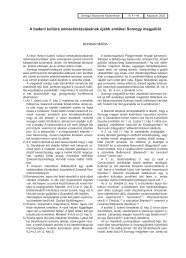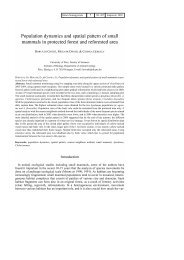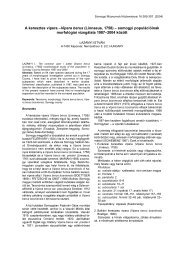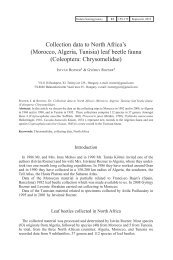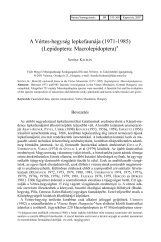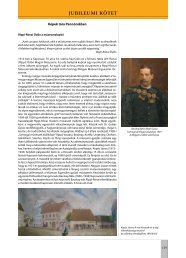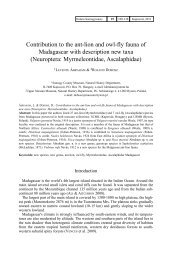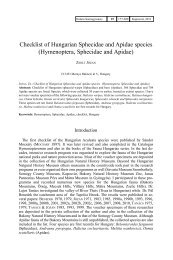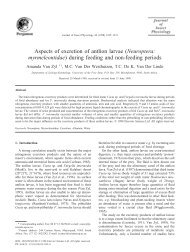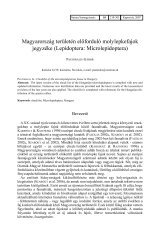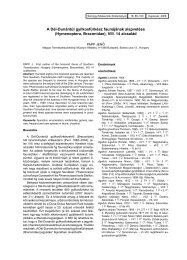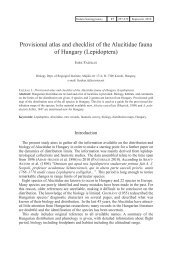Study on the Palaearctic Pristiphora species (Hymenoptera ...
Study on the Palaearctic Pristiphora species (Hymenoptera ...
Study on the Palaearctic Pristiphora species (Hymenoptera ...
Create successful ePaper yourself
Turn your PDF publications into a flip-book with our unique Google optimized e-Paper software.
HARIS A.: STUDY ON THE PALAEARCTIC PRISTIPHORA SPECIES<br />
241<br />
densely and finely punctured, moderately shiny. Meopleur<strong>on</strong> densely and finely punctured,<br />
clearly shiny.]...............................................................................P. trilobita Haris<br />
M<strong>on</strong>golia.<br />
- Penis valve without three lobes...............................................................................16.<br />
15. Anterior margin of clypeus straight....................................................................17.<br />
- Penis valve in Fig. 82. Anterior margin of clypeus emarginated. 3.5-4.5 mm.<br />
....................................................................................................P. abbreviata (Hartig)<br />
17. Penis valve in Fig. 81. 3.0 mm. Female unknown.................P. exigua (Lindqvist)<br />
- Penis valve in Fig. 134. 3.9 mm. Female unknown. [Black. Tegula, fore clypeal margin,<br />
fore and middle coxae, trochanters, fore and middle femora dominantly, mostly <strong>the</strong><br />
tibiae, fore and middle tarsi and last abdominal sternite yellowish ochraceous.<br />
Mes<strong>on</strong>otum densely and finely punctured, moderately shiny. Mesopleur<strong>on</strong> densely punctured,<br />
shiny. Claws without inner tooth.].................................P. nigrogroenblomi Haris<br />
M<strong>on</strong>golia.<br />
18. Penis valve in Fig. 83. 3.0-4.0 mm..........................................P. retusa (Thoms<strong>on</strong>)<br />
- Larger <strong>species</strong>, penis valve different.......................................................................19.<br />
19. Penis valve in Fig. 84. 4.5-5.0 mm...........................................P. biscalis (Förster)<br />
- Penis valve in Fig. 85. 5.5-7.0 mm.............................................P. maesta (Zaddach)<br />
20. Six <strong>species</strong> differentiated by <strong>the</strong>ir penis valve as follows:<br />
a. Penis valve in Fig. 66................................................................P. angulata Lindqvist<br />
b. Penis valve in Fig. 142. Female unknown. [Labrum, narrow hind pr<strong>on</strong>otal margin<br />
and tegula white.] 5.8 mm.............................................................P. hoverlaensis Haris<br />
Known from Subcarpathia and Romania.<br />
c. Penis valve in Fig. 103. [Pr<strong>on</strong>otal corners, tegula and mostly <strong>the</strong> legs pale brown.<br />
Most of <strong>the</strong> coxae black and <strong>the</strong> bases, especially underside, of femora with black lines.]<br />
5.0 mm.....................................................................................P. truncatiserra Lindqvist<br />
d. Penis valve in Fig. 138. Pr<strong>on</strong>otum dominantly black, its corners whitish and <strong>the</strong> lateral<br />
margin of <strong>the</strong> pr<strong>on</strong>otum. Apices of hind tibiae and apical segments of tarsi black.<br />
4.0-6.5 mm. See also notes.....................................................................P. laricis (Hartig)<br />
e. Penis valve in Fig. 139. Hind tibiae and tarsi black. 7.0-7.5 mm.<br />
.....................................................................................................P. funerula (A. Costa)<br />
f. Penis valve in Fig. 68. Colour similar to that of P. laricis (Hartig). Pr<strong>on</strong>otum dominantly<br />
white or its wide hind and lateral margines white. 5.2-5.5 mm. See also notes<br />
....................................................................................................P. nigrocarpa (Takagi)<br />
Descripti<strong>on</strong> of <strong>the</strong> new <strong>species</strong> and notes <strong>on</strong> o<strong>the</strong>r <strong>species</strong><br />
<strong>Pristiphora</strong> araratensis sp. n.<br />
Female. Black, including antennae, mouthparts and palpi. All coxae and trochanters,<br />
basal fifth of hind femur, basal third of middle and fore femora black. Apical three segments<br />
of tarsi darkened. O<strong>the</strong>r parts of legs: <strong>the</strong> remaining parts of femora, entire tibiae,<br />
first and sec<strong>on</strong>d segments of tarsi ochraceous. Venati<strong>on</strong> black. Costa, subcosta and stigma<br />
dark brown. Wings dark infuscate (darkest in <strong>the</strong> genus <strong>Pristiphora</strong>). Head moderately<br />
densely and moderately deeply punctured, shiny. Fr<strong>on</strong>tal area not marked. Distance<br />
of <strong>the</strong> hind ocellus from <strong>the</strong> hind margin of <strong>the</strong> head about as l<strong>on</strong>g as <strong>the</strong> diameter of an<br />
ocellus. Mes<strong>on</strong>otum, mesoscutellum, mesoscutellar appendage and mesopleur<strong>on</strong> str<strong>on</strong>gly<br />
shiny, hardly, sporadically, superficially and shallowly punctured. Ratios of <strong>the</strong> antennal<br />
segments: 9 : 5 : 30 : 30 : 30 : 26 : 27 : 23 : 25. L<strong>on</strong>gest diameter of <strong>the</strong> eye : length<br />
of third antennal segment: 1 : 1. Maximal width of hind tibia : length of inner hind tib-



